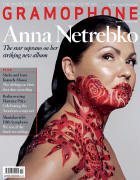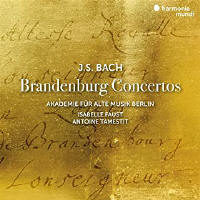Texte paru dans: / Appeared in: |
|
|
Outil de traduction (Très approximatif) |
|
|
Reviewer: Lindsay Kemp It’s heartening that this, the Akademie für Alte Musik Berlin’s second recording of the Brandenburg Concertos, took place in the same venue as their 24-year-old first (2/99), and that 10 of its members play on both; after all, the new one celebrates the 30th anniversary of this tight-knit little band. This time, however, they have invited two distinguished guests to join in the fun: violinist Isabelle Faust (whose Bach concertos with them – 4/19 – were such a pleasure) and Antoine Tamestit (who recorded Telemann concertos with them last year). Not that they take over the show. Faust is only in Nos 3 and 4 (one of the Akademie’s two concertmasters, Georg Kallweit, is the violin soloist in Nos 1 and 5 and the other, Bernhard Forck, in No 2); and Tamestit plays only in the ensemble concertos, Nos 3 and 6. More a meeting of friends, then, than star vehicle, and fittingly the performances have a real sense of communal enjoyment. Thus there is a bracing bigness to No 5, bringing a vibrancy to the first movement that can be missing from some performances. Christoph Huntgeburth’s flute sounds gorgeous, and there is an effective momentary ‘what-next?’ standstill at the head of the solo harpsichord cadenza, before Raphael Alpermann starts on the long road back. And the last movement hits just the right balance of forward movement and bounce. In No 4 I liked the way the violin’s first solo recedes for a moment of introspection before surging back as the recorders rejoin, but there are other times when it dominates too much, the recorders relegated to a sort of halo. The last movement is excitingly fast, not always as clear in its exhilarating counterpoint as it could be, but has good shape. Standards of period instrumental playing, and indeed of instrument-making, have taken great strides since 1997, and a significant way in which the new recording scores over the first is best shown in Concerto No 2, a much more comfortable affair than before, in which subtler shaping of line and easily natural balance bring a new level of swirling energy. The lithe energy of their First Concerto is undermined by a somewhat muffled sound, but it is fun to hear the silvery grain of the piccolo violin peeking out and the horn players relishing the different roles they get to play. The varied tempos and characterisations of the finale’s chain of dances seem a good idea at first but ultimately damage its coherence. The most naturally exciting performances, to my ear, are the two string concertos. The violas are larger-than-life in No 6, enabling Tamestit and Sabine Fehlandt to unfold warmly expressive duetting in the slow movement and ebulliently incisive taggames in the outer ones. And No 3 – swiftflying but with deft articulation and balance allied to a keen sense of architecture that allow every line of counterpoint to live and shine – is a real winner. |
|




